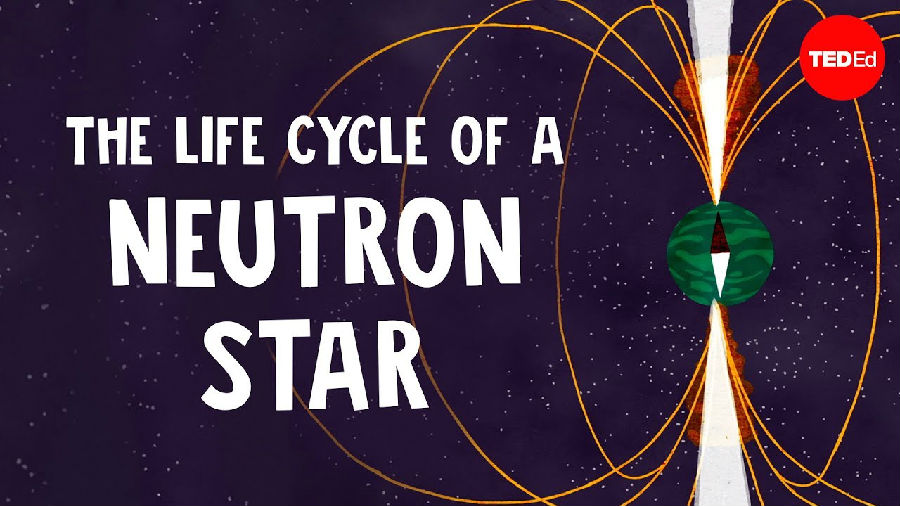About once every century, a massive star somewhere in our galaxy runs out of fuel.
大约每个世纪一次,在我们银河中的某处一个巨大的星体会用光燃料。
This happens after millions of years of heat and pressure
这种情况发生是因为百万年来的高温与高压,
have fused the star's hydrogen into heavier elements like helium, carbon, and nitrogen -- all the way to iron.
把星体的氢合成了更重的元素,像是氦、碳、氮--一直到铁。
No longer able to produce sufficient energy to maintain its structure,
无法再产生足够的能量来维持其结构,
it collapses under its own gravitational pressure and explodes in a supernova.
星体会因自身的引力坍塌,爆炸成超新星。
The star shoots most of its innards into space, seeding the galaxy with heavy elements.
星体会将其大部分的物质射入宇宙中把重元素散播到星系中。
But what this cataclysmic eruption leaves behind might be even more remarkable:
不过这剧烈爆炸留下来的东西可能更惊人:
a ball of matter so dense that atomic electrons collapse from their quantum orbits into the depths of atomic nuclei.
一团物质,其密度高到原子中的电子会从量子轨道坍缩到原子核的深处。
The death of that star is the birth of a neutron star:
这个星体的死亡成了一颗中子星的诞生:
one of the densest known objects in the universe, and a laboratory for the strange physics of supercondensed matter.
宇宙中已知密度最大的物体之一,它还是有关超凝聚体的奇异物理的实验室。
But what is a neutron star?
但中子星到底是什么?
Think of a compact ball inside of which protons and electrons fuse into neutrons and form a frictionless liquid called a superfluid -- surrounded by a crust.
想象一个紧实的球,在它里面质子和电子融合成中子形成一种零摩擦力的流体,叫做超流体--被一层外壳包起来。
This material is incredibly dense -- the equivalent of the mass of a fully-loaded container ship squeezed into a human hair,
这种材料有非常高的密度--相当于把一个满载的货船的质量挤到一根人的头发上,
or the mass of Mount Everest in a space of a sugar cube.
或者把珠穆朗玛峰的质量挤到一块方糖的大小中。
Deeper in the crust, the neutron superfluid forms different phases that physicists call "nuclear pasta,"
在外壳的更深处,中子超流体构成不同的形态物理学家管它叫“核面食”,
as it's squeezed from lasagna to spaghetti-like shapes.
因为它被压缩成千层面到意大利面的形状。
The massive precursors to neutron stars often spin.
中子星巨大的前身通常会旋转。
When they collapse, stars that are typically millions of kilometers wide compress down to neutron stars that are only about 25 kilometers across.
当它们坍塌时,典型的有几百万公里宽的星体压缩成只有25公里宽的中子星。
But the original star's angular momentum is preserved.
但是原始星体的角动量不会改变。
So for the same reason that a figure skater's spin accelerates when they bring in their arms,
所以就像花样滑冰运动员把手臂收进来就能加速旋转的道理一样,
the neutron star spins much more rapidly than its parent.

The fastest neutron star on record rotates over 700 times every second,
记录中最快的中子星每秒会旋转超过700次,
which means that a point on its surface whirls through space at more than a fifth of the speed of light.
意味着它的表面上的一个点在太空中的移动速度比光速的五分之一还要快。
Neutron stars also have the strongest magnetic field of any known object.
中子星还有所有已知物体中最强的磁场。
This magnetic concentration forms vortexes that radiate beams from the magnetic poles.
这种磁力的集中会形成漩涡它会从磁极发射出光束。
Since the poles aren't always aligned with the rotational axis of the star,
因为磁极并不一定和星体旋转轴对齐,
the beams spin like lighthouse beacons, which appear to blink when viewed from Earth.
这些光束会像灯塔指示灯一样旋转,从地球看就像是在闪烁。
We call those pulsars. The detection of one of these tantalizing flashing signals by astrophysicist Jocelyn Bell in 1967
我们称这些天体为脉冲星。1967年天体物理家乔瑟琳·贝尔探测到的这激动人心的闪烁信号
was in fact the way we indirectly discovered neutron stars in the first place.
实际上是我们最一开始间接发现中子星的方法。
An aging neutron star's furious rotation slows over a period of billions of years
衰老的中子星的激烈旋转会在数十亿年的时间里减慢,
as it radiates away its energy in the form of electromagnetic and gravity waves.
因为它以电磁波和引力波的形式辐射出它的能量。
But not all neutron stars disappear so quietly.
但不是所有中子星都会这么安静的消失。
For example, we've observed binary systems where a neutron star co-orbits another star.
比如,我们曾经观测到双星系统其中一颗中子星和另一颗绕着同一中心。
A neutron star can feed on a lighter companion,
一个中子星可以蚕食轻一点的同伴,
gorging on its more loosely bound atmosphere before eventually collapsing cataclysmically into a black hole.
吞食它没有紧密吸引住的大气层,然后最终剧烈坍塌成为黑洞。
While many stars exist as binary systems, only a small percentage of those end up as neutron-star binaries,
虽然很多星体都存在于双星系统中,但只有一小部分会形成中子星双星系统,
where two neutron stars circle each other in a waltz doomed to end as a merger.
其中两颗中子星像跳着华尔兹一样绕着彼此直至注定的合并。
When they finally collide, they send gravity waves through space-time like ripples from a stone thrown into a calm lake.
当它们最终相撞,它们会向时空中发射引力波,像投进平静湖面的一块石头造成的涟漪。
Einstein's theory of General Relativity predicted this phenomenon over 100 years ago,
爱因斯坦的广义相对论一百多年前就预测了这种现象,
but it wasn't directly verified until 2017, when gravitational-wave observatories LIGO and VIRGO observed a neutron star collision.
但是直到2017年它并未被直接证明,当引力波探测器LIGO和VIRGO观测到了中子星碰撞。
Other telescopes picked up a burst of gamma rays and a flash of light, and, later, x-rays and radio signals, all from the same impact.
其他望远镜探测到了一阵伽玛射线和一道闪光,之后是X射线和无线电信号,都是从同一个碰撞而来。
That became the most studied event in the history of astronomy.
这变成了天文史上被研究最多的事件。
It yielded a treasure trove of data that's helped pin down the speed of gravity, bolster important theories in astrophysics,
它提供了一众珍贵的数据帮助我们确定了引力的速度,支持天体物理中重要的理论,
and provide evidence for the origin of heavy elements like gold and platinum.
并为像金和铂这些重元素的来源提供了证据。
Neutron stars haven't given up all their secrets yet.
中子星还并未吐露出它们所有的秘密。
LIGO and VIRGO are being upgraded to detect more collisions.
LIGO和VIRGO正在被升级来检测更多碰撞。
That'll help us learn what else the spectacular demise of these dense, pulsating, spinning magnets can tell us about the universe.
这会帮助我们了解这些高密度的、脉动的、旋转的磁铁壮观的消亡,还能告诉我们什么其他关于宇宙的知识。


